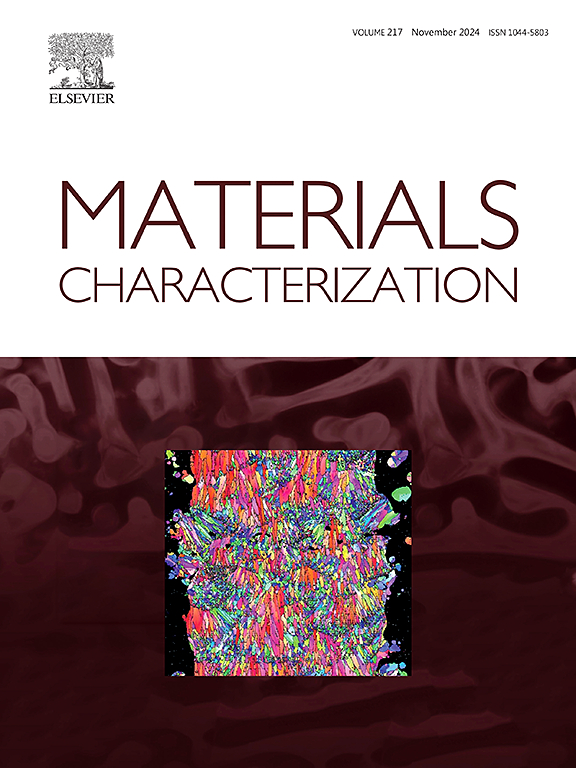尺寸对铜铌纳米复合材料丝中多尺度铜纹理的影响
IF 4.8
2区 材料科学
Q1 MATERIALS SCIENCE, CHARACTERIZATION & TESTING
引用次数: 0
摘要
通过累积拉伸和捆绑(ADB)制备的铜铌纳米复合材料线呈现出多尺度的微观结构:铜的尺寸从微米到纳米不等,而铌的尺寸为纳米级。本研究利用电子反向散射衍射(EBSD)和前驱电子衍射(PED)分别表征了微米/亚微米级和纳米级铜(铌)的纹理。结果表明,不同尺寸尺度的铜的纹理差异很大。微米和亚微米尺度的铜沿金属丝的径向显示出明显的纹理梯度,而纳米尺度的铜和铌纤维则具有均匀分布的纹理。微米尺度的铜在金属丝中心区域具有〈111〉纹理,在边缘具有随机纹理;亚微米尺度的铜在中心区域具有强烈的〈100〉纹理,在边缘区域具有〈111〉纹理;纳米尺度的铜和铌纤维在整个金属丝上分别具有强烈的〈111〉和〈110〉纹理。变形过程中的动态再结晶导致微米级铜的纹理强度减弱,而亚微米级和纳米级铜/铌的纹理由于尺寸和界面效应而受到的影响几乎可以忽略不计。本文章由计算机程序翻译,如有差异,请以英文原文为准。
Size effect on texture of multiscale Cu in CuNb nanocomposite wires
Cu![]() Nb nanocomposite wires prepared by accumulative drawing and bundling (ADB) exhibit multiscale microstructures: the size of Cu ranges from micrometer to nanometer, and Nb is nano-scale. In this work, Electron backscattering diffraction (EBSD) and precession electron diffraction (PED) are used to characterize the textures of micron−/submicron-scale and nano-scale Cu (Nb), respectively. The results indicate that the texture of Cu at different size scales varies significantly. Micron- and submicron-scale Cu shows noticeable texture gradients along the radial direction of wires, whereas nano-scale Cu and Nb fibers have homogeneously distributed textures. Micron-scale Cu has a 〈111〉 texture in wire center region and a random texture in edge; submicron-scale Cu develops a strong 〈100〉 texture in center and a < 111> texture in edge region; nano-scale Cu and Nb fibers exhibit strong 〈111〉 and 〈110〉 textures throughout the wire, respectively. Dynamic recrystallization during deformation leads to weakening of the texture strength in micron-scale Cu, while almost negligible effects on the texture of submicron- and nano-scale Cu/Nb due to the size and interface effects.
Nb nanocomposite wires prepared by accumulative drawing and bundling (ADB) exhibit multiscale microstructures: the size of Cu ranges from micrometer to nanometer, and Nb is nano-scale. In this work, Electron backscattering diffraction (EBSD) and precession electron diffraction (PED) are used to characterize the textures of micron−/submicron-scale and nano-scale Cu (Nb), respectively. The results indicate that the texture of Cu at different size scales varies significantly. Micron- and submicron-scale Cu shows noticeable texture gradients along the radial direction of wires, whereas nano-scale Cu and Nb fibers have homogeneously distributed textures. Micron-scale Cu has a 〈111〉 texture in wire center region and a random texture in edge; submicron-scale Cu develops a strong 〈100〉 texture in center and a < 111> texture in edge region; nano-scale Cu and Nb fibers exhibit strong 〈111〉 and 〈110〉 textures throughout the wire, respectively. Dynamic recrystallization during deformation leads to weakening of the texture strength in micron-scale Cu, while almost negligible effects on the texture of submicron- and nano-scale Cu/Nb due to the size and interface effects.
求助全文
通过发布文献求助,成功后即可免费获取论文全文。
去求助
来源期刊

Materials Characterization
工程技术-材料科学:表征与测试
CiteScore
7.60
自引率
8.50%
发文量
746
审稿时长
36 days
期刊介绍:
Materials Characterization features original articles and state-of-the-art reviews on theoretical and practical aspects of the structure and behaviour of materials.
The Journal focuses on all characterization techniques, including all forms of microscopy (light, electron, acoustic, etc.,) and analysis (especially microanalysis and surface analytical techniques). Developments in both this wide range of techniques and their application to the quantification of the microstructure of materials are essential facets of the Journal.
The Journal provides the Materials Scientist/Engineer with up-to-date information on many types of materials with an underlying theme of explaining the behavior of materials using novel approaches. Materials covered by the journal include:
Metals & Alloys
Ceramics
Nanomaterials
Biomedical materials
Optical materials
Composites
Natural Materials.
 求助内容:
求助内容: 应助结果提醒方式:
应助结果提醒方式:


